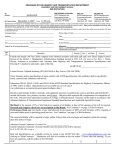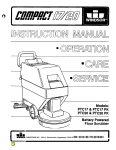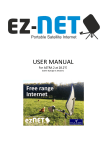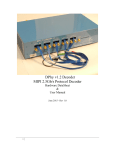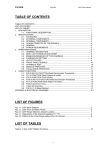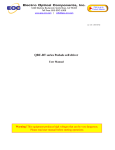Download Baseline Test Procedures in format
Transcript
National Model Railroad Association (NMRA) Inc. Digital Command Control (DCC) Baseline Mobile And Accessory Decoder Test Procedures Version 0.2 19 August, 1997 19-Aug-97 1 of 14 Test Rules and Assumptions Rules for applying for a decoder conformance seal or requesting conformance testing: 1) All applications for a decoder conformance seal must be accompanied by the following: A. A decoder for which conformance is to be tested. B. A complete set of user documentation. C. Any special instructions for connecting the decoder to the test jig as described in NMRA DCC Decoder Test User Manual. D. Certification that the attached test procedures have been successfully completed by the manufacture prior to submission for formal conformance testing. E. The manufacture must provide evidence that the decoder complies with the FCC Part 15 rules. Please attach a copy of the FCC report. F. A completed LOCOMOTIVE DECODER QUESTIONNAIRE or ACCESSORY DECODER QUESTIONNAIRE for the decoder to be tested. 2) The NMRA may be petitioned to aid a manufacturer by testing a decoder prior to formal conformance testing on a time available basis. If so petitioned, the manufacture must supply at a minimum the following: A. The decoder to be tested. B. A set of user documentation or notes on the proper use of the decoder. C. Any special instructions for connecting the decoder to the test jig as described in NMRA DCC Decoder Test User Manual. D. A completed LOCOMOTIVE DECODER QUESTIONNAIRE or ACCESSORY DECODER QUESTIONNAIRE for the decoder to be tested. Rules for achieving S9.1 and S9.2 conformance 1) All Standards (S9.1 and S9.2) must be met in their entirety. Accessory Decoder Packet Format, section of RP 9.2.1 section D, must be met for an accessory decoder in addition to S9.1 and S9.2. Associated documents 1) NMRA DCC Decoder Test User Manual. This document provides instructions for building the decoder test jig, installing the decoder test hardware, and installing the decoder test software. 2) NMRA Digital Command Control Standards & Recommended Practices. This document contains standard S9.1, S9.2, and RP 9.2.1 section D which are the basis for these decoder tests. 19-Aug-97 3 of 14 Decoder Information Decoder Unit Under Test: Manufacturer: Model Number: Serial Number Firmware Version/Date: Tester Name: _____________________________________ Testing Start Date: _________________ Tester Signature: _____________________________________ Testing Completion Date: _________________ Witness (optional): _____________________________________ Testing Start Date: Witness Signature: _____________________________________ Testing Completion Date: _________________ 19-Aug-97 _________________ 4 of 14 Test Equipment Setup The following test equipment is required for decoder testing. The test operator must be familiar with the correct operation of this equipment. 1) Conforming DCC booster. 2) Noise injecting DCC booster. 3) Oscillator capable of producing a 100 KHz sine wave of at least 10 Volts RMS into a 600 Ohm load. This is for use with the noise injecting booster. 4) DC power supply capable of producing at least 1 Amp of current at 20 Volts. This is for use with the noise injecting booster. 5) Decoder test jig as shown in Figure 1: Test Jig Schematic. 6) NMRA DCC decoder test board installed into a PC. See the reference document NMRA DCC Decoder Test User Manual for full instructions on installing and configuring the decoder test board hardware and software. 7) Oscilloscope capable of measuring DCC signal levels and risetimes. An oscilloscope with differential A and B channels is preferred but a single channel oscilloscope can be used by measuring each of the booster track output signals individually with reference to system ground. 8) Voltmeter capable of reading peak decoder DCC signal input AC Voltages and decoder output DC Voltages. The test equipment should be connected as shown in Figure 1: Test Jig Schematic. The noise injecting booster should be set up as shown in Figure 2: Noise Injecting Booster Connections. 19-Aug-97 5 of 14 GND (1) DCCA (2) DCCB (3) GND INA INB PC TRACK+ TRACK+ TRACK- TRACK- Booster Decoder 2200 Ω MOTOR + [Out 1 left] IN0A (9) + 47 uFd 20 Volt 100 Ω 5 Watt + IN0B (10) 2200 Ω MOTOR[Out 1 right] Figure 1: Test Jig Schematic 19-Aug-97 6 of 14 AC 20 Volt Power Supply + U − V INA C INB D GND Y Peak AC Voltmeter COM J Noise Injecting Booster TRACK+ 100 Ω 5 Watt K TRACK+ X OUT Sine Wave Generator GND Oscilloscope System Ground Reference Note: B Channel Is Optional IOptional A B Figure 2: Noise Injecting Booster Connections 19-Aug-97 7 of 14 Test Procedures Equipment Setup For Manual Tests 1) For a mobile decoder, program the decoder for the proper address and 14 speed step baseline operation. The motor control variables should be set to give the largest motor Voltage changes between speed steps possible with the minimum acceleration and braking momentum. The tests assume that the locomotive decoder can go from half speed reverse to stop within one second of receiving an emergency stop command. For an accessory decoder, program the decoder for the proper address. The accessory decoder should be programmed to keep the switch output active for at least one second for the tests to work reliably. 2) Connect conforming booster as per Figure 1: Test Jig Schematic. 3) Start decoder test program in manual mode by typingC:\> send -m for a mobile decoder or C:\> send -d a -m for an accessory decoder. 4) Enter appropriate decoder information when prompted. 5) Verify self tests have passed 19-Aug-97 8 of 14 Manual Decoder Tests Standard/RP S9.1 and S9.2. Requirements Decoder must respond to RESET command defined in S9.2. Test Action 1. 2. S9.1 - S9.2 for a mobile decoder. RP 9.2.1 section D, Accessory Decoder Packet Format for an accessory decoder. Decoder must respond to all baseline commands defined in S9.2 for a mobile decoder or RP 9.2.1 section D for an accessory decoder. 3. 4. 5. 19-Aug-97 Decoder Response Pass Fail Enter the RESET command >> r at the prompt. Verify that the decoder enters the RESET state. Enter the DCC packet command >> d at the prompt. Verify that decoder responds to each baseline command with an observable change to its output. Use the >> s and/or >> f commands to send each baseline packet. Measure the decoder output using the oscilloscope or Voltmeter. Exit the test program by typing >> q at the prompt. 9 of 14 Decoder Setup And Automated Tests With The Conforming Booster Standard/RP Requirements Test Action Decoder Response Pass Fail 1. S9.1 - S9.2 for a mobile decoder. RP 9.2.1 section D, Accessory Decoder Packet Format for an accessory decoder. 19-Aug-97 Decoder is required to pass the appropriate sections of the specification. The program will automatically run the tests and log the results. Decoder should be programmed and connected as specified in the manual test section. 2. Connect conforming booster as per Figure 1: Test Jig Schematic. 3. Start decoder test program in automatic mode by typingC:\> send for a mobile decoder or C:\> send -d a for an accessory decoder. 4. Enter appropriate decoder information when prompted. 5. Verify self tests have passed. 6. The program will run tests for approximately 12 hours and exit. 7. At the conclusion of the test, verify that at least 95% of all packet acceptance tests pass except for ‘pre 10 idle 0’ which is allowed to fail. 8. Verify that 100% of the bad address and bad bit tests pass. 9. Verify that 1T margin test is within S9.1 limits. 10. Verify that the 1 bit duty cycle test is within limits. 10 of 14 Equipment Setup For Automated Tests With Noise Injecting Booster 1) Decoder should be programmed and connected as specified in the manual test section. 2) Connect the noise injecting booster as per Figure 1: Test Jig Schematic and Figure 2: Noise Injecting Booster Connections. 3) Start decoder test program in manual mode by typingC:\> send -m for a mobile decoder or C:\> send -d a -m for an accessory decoder. 4) Enter appropriate decoder information when prompted. 5) Verify self tests have passed. 6) Enter the DCC packet command >> d at the prompt. 7) For a mobile decoder, enter the commands to turn on the lamp output and set the motor output to ½ speed reverse. For an accessory decoder, turn on output 1. 8) If the decoder supports separate power and DCC signal inputs, apply power per the manufacturers recommendation. Adjust the separate DCC signal input to a level of 4 Volts peak using the front panel knob. Note: this is a signal of -4 Volts to +4 Volts peak to peak. If the decoder has merged power and signal input leads, slowly reduce the noise injecting booster signal Voltage by turning the front panel knob counterclockwise until the decoder ceases to work. Observe the peak Voltage at this point and then increase the peak Voltage by 1.0 Volt (2 Volts peak to peak). The decoder should be running normally at this point. 9) Enter the minimum and test Voltages arrived at in step 8. The minimum and test Voltage should both be 4 Volts peak for a decoder with separate power and signal inputs. The minimum Voltage should be 1 Volt less than the test Voltage for a decoder with merged power and signal inputs. (Note: The peak Voltages entered below are ½ the peak to peak Voltages): Minimum DCC Voltage For Operation(Vpeak): Volts DCC Test Voltage (Vpeak): Volts 10) Add 100 KHz sine wave noise to the signal until the peak noise Voltage is 25% of the peak signal Voltage. 11) Verify that the rise and fall time switches are both set to ‘4’ for a rise and fall time of 2 Volts/usec. 19-Aug-97 11 of 14 12) Exit the test program by typing >> q at the prompt. 19-Aug-97 12 of 14 Tests With The Noise Injecting Booster And Decoder Input Leads In The Normal Position Standard/RP Requirements Test Action Decoder Response Pass Fail 1. S9.1 - S9.2 for a mobile decoder. RP 9.2.1 section D, Accessory Decoder Packet Format for an accessory decoder. 19-Aug-97 Decoder is required to pass the appropriate sections of the specification. The program will automatically run the tests and log the results. Equipment should be set up as specified in Equipment Setup For Automated Tests With Noise Injecting Booster. 2. Connect conforming booster as per Figure 1: Test Jig Schematic with decoder input leads in the NORMAL position. 3. Start decoder test program in automatic mode by typingC:\> send for a mobile decoder or C:\> send -d a for an accessory decoder. 4. Enter appropriate decoder information when prompted. 5. Verify self tests have passed. 6. The program will run tests for approximately 12 hours and exit. 7. At the conclusion of the test, verify that at least 95% of all packet acceptance tests pass except for ‘pre 10 idle 0’ which is allowed to fail. 8. Verify that 100% of the bad address and bad bit tests pass. 9. Verify that 1T margin test is within S9.1 limits. 10. Verify that the 1 bit duty cycle test is within limits.. 13 of 14 Tests With The Noise Injecting Booster And Decoder Input Leads In The Reversed Position Standard/RP Requirements Test Action 1. Equipment should be set up as specified in Equipment Setup For Automated Tests With Noise Injecting Booster. 2. Connect conforming booster as per Figure 1: Test Jig Schematic with decoder input leads in the REVERSED position. Start decoder test program in automatic mode by typingC:\> send for a mobile decoder or C:\> send -d a for an accessory decoder. Enter appropriate decoder information when prompted. Verify self tests have passed. The program will run tests for approximately 12 hours and exit. 3. 4. S9.1 - S9.2 for a mobile decoder. RP 9.2.1 section D, Accessory Decoder Packet Format for an accessory decoder. Decoder is required to pass the appropriate sections of the specification. The program will automatically run the tests and log the results. 5. 6. Decoder Response Pass Fail 7. At the conclusion of the test, verify that at least 95% of all packet acceptance tests pass except for ‘pre 10 idle 0’ which is allowed to fail. 8. Verify that 100% of the bad address and bad bit tests pass. 9. Verify that 1T margin test is within S9.1 limits. 10. Verify that the 1 bit duty cycle test is within limits.. 19-Aug-97 14 of 14
















